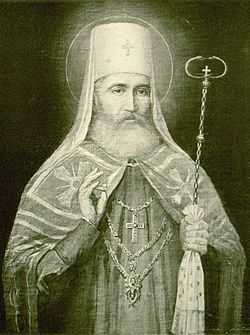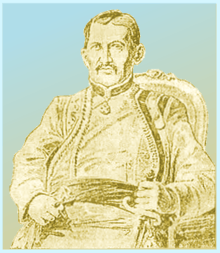Petar I Petrović Njegoš
| Peter I | |
|---|---|
| Prince-Bishop of Montenegro | |
 | |
| Native name | Петар I |
| Installed | 1782 |
| Term ended | 1830 |
| Predecessor | Sava II |
| Successor | Peter II |
| Personal details | |
| Born |
1748 Njeguši, Montenegro |
| Died |
1830 Cetinje, Montenegro |
| Denomination | Serbian Orthodox Christian |
| Residence | Cetinje |
| Parents | Marko Petrović and Anđelija Martinović |
| Coat of arms |
 |
| Sainthood | |
| Feast day | October 31 (Gregorian calendar), October 18 (Julian calendar) |
| Venerated in | Eastern Orthodox Church |
| Title as Saint | St Peter of Cetinje |
| Canonized | by Serbian Orthodox Church |
Petar I Petrović Njegoš (Serbian Cyrillic: Петар I Петровић Његош; 1747–1830) was the ruler of the Prince-Bishopric of Montenegro as the Metropolitan (vladika) of Cetinje, and Exarch (legate) of the Serbian Orthodox Church throne. He was the most popular spiritual and military leader from the Petrović dynasty. During his long rule, Petar strengthened the state by uniting the often quarreling tribes, consolidating his control over Montenegrin lands, introducing the first laws in Montenegro (Zakonik Petra I) . He was canonized by the Montenegrian Church as "St. Peter of Cetinje" (Свети Петар Цетињски).
He was described as "a man of uncommon size, handsome features, considerable talent, and a highly respected character" by Therese Albertine Luise Robinson.[1]
Life
Against the Ottoman Empire (1785–96)
He had benefited from four years' schooling in a military college (1762-1766) in Imperial Russia, was known to have been Vasilije III Petrović-Njegoš's choice as successor, and had strong support among the clan chiefs. He had unquestioned moral authority strengthened by his military successes. His rule prepared Montenegro for the subsequent introduction of modern institutions of the state: taxes, schools and larger commercial enterprises.
He was made a bishop by Mojsije Putnik of the Metropolitanate of Karlovci at Sremski Karlovci on the 13th of October 1784. During his long trip to Russia that year and the following (1785), Montenegro was attacked by Turkish forces. When Vladika Petar I returned from Russia, he began a war of liberation. At the crucial Battle of Krusi (a village in Lješanska nahija) the Turkish Army of 30,000 led by Mahmut-Paša Bušatlija and assisted with seven French officers was defeated with heavy casualties by a force of 6,000 Montenegrins led by Vladika Petar I (3 Oct. 1796). In this famous battle Mahmut-pasha was killed. After the victory Petar enlarged the territory of Montenegro and became virtually independent of the Ottoman Empire.
Against the French Empire (1806–07)

In 1806, the troops of Napoleonic France advanced toward the Bay of Kotor in Montenegro. The Montenegrin army led by Vladika Petar I, aided by several Russian battalions and the fleet of Admiral Dmitry Senyavin pushed them back to Dubrovnik. But soon after, Russian Tsar Alexander I asked Montenegrins to relinquish control of Boka to Austria. However, after Montenegrins retreated to Herceg Novi, Alexander changed his mind again, and with a help of Montenegrins conquered Brač and Korčula. In the meantime, France encouraged Turkey to attack Russia, which withdrew its fleet from the Adriatic to defend the Ionian islands. The Treaty of Tilsit (1807) between Russia and France granted the control of the Bay of Kotor to France.
Against the Ottoman Empire (1820)
In 1820, in the north of Montenegro, the highlanders from Morača led by Serdar Mrkoje Mijušković won a major battle against the Turkish force in Bosnia.
Petar I waged a successful campaign against the bey of Bosnia in 1819. The repulse of an Ottoman invasion from Albania during the Russo-Turkish War (1828–29) led to the recognition of Montenegrin sovereignty over Piperi.[2] Petar I had managed to unite the Piperi and Bjelopavlići with Montenegro,[2] and when Bjelopavlići and the rest of the Hills (Seven hills) were joined into Peter's state, the polity officially called "Black Mountain (Montenegro) and the Hills".[3]
Ideology
Petar was the conceiver of a plan to form a new Serbian Empire out of Bosnia, Serbia, Herzegovina and Montenegro with Boka, with Dubrovnik as its Imperial Capital. In 1807, he sent a letter to the Russian General of the Danube Army regarding this subject: "The Russian Czar would be recognized as the Tsar of the Serbs and the Metropolitan of Montenegro would be his assistant. The leading role in the restoration of the Serbian Empire belongs to Montenegro."
Canonisation

He was canonised as Saint Peter of Cetinje by his successor Petar II Petrović Njegoš. The Serbian Orthodox Church celebrates him on October 31, Gregorian calendar, which is October 18 in the Julian calendar.
Works
- The Lore in Verse (Поучење у стиховима)
- The Sons of Ivan-bey (Синови Иванбегови)
- Poem to Karageorge (Пјесма Карађорђу)
- To Serb Christmas Eve (Српско Бадњи вече)
References
- ↑ Talvj. Historical View of the Language and Literature of the Slavic Nations: With a Sketch of Their Popular Poetry. G.P. Putnam. pp. 120–.
- ↑ 2.0 2.1 Miller, p. 142
- ↑ Etnografski institut (Srpska akademija nauka i umetnosti) (1952). Posebna izdanja, Volumes 4-8. Naučno delo. p. 101.
Када, за владе Петра I, црногорсксу држави приступе Б^елопавлиЬи, па после и остала Брда, онда je, званично, „Црна Гора и Брда"
Sources
- William Miller (12 October 2012). The Ottoman Empire and Its Successors 1801-1927. Routledge. ISBN 978-1-136-26046-9.
- Jevto M. Milović (1987). Petar I Petrović Njegoš: pisma i drugi dokumenti. Istorijski institut SR Crne Gore.
- Branko Pavićević (2007). Petar I Petrović Njegoš. CID.
External links
- Свети Петар Цетињски: Житије, дјело, молитва
- Speeches to Montenegrins before battles against Turks on Martinici and on Krusi, 1796
- of Petar I
| Religious titles | ||
|---|---|---|
| Preceded by Sava |
Metropolitan of Montenegro and the Hills 1782–1830 |
Succeeded by Petar II |
| ||||||||||||||||||||||||||||||||||||||||||||||||||||||||||||||||||||||||
|